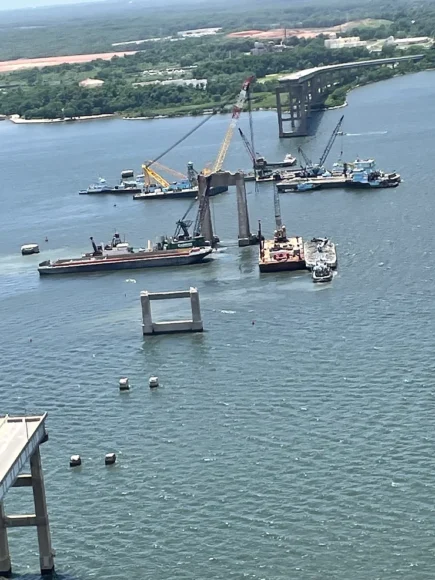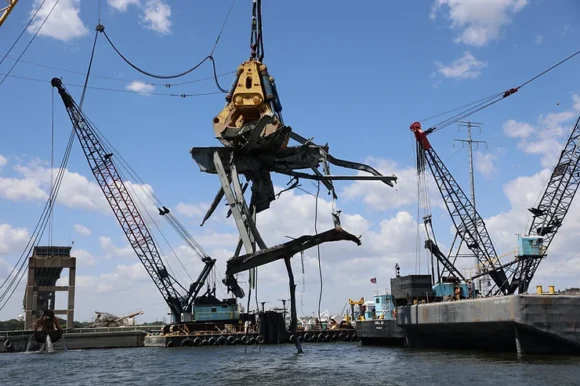Seventy-six days after it was blocked by the collapse of the Key Bridge, the major shipping channel through the Port of Baltimore has been cleared of debris and restored to allow commercial maritime transit.
The U.S. Army Corps of Engineers and U.S. Navy Supervisor of Salvage and Diving announced that recovery teams have restored the Fort McHenry Federal Channel to its original operational dimensions of 700 feet wide and 50 feet deep.
“We’ve cleared the Fort McHenry Federal Channel for safe transit,” said Col. Estee Pinchasin, Baltimore District commander.
Fully restoring the channel to its original width and depth involved refloating and removing the ship from the channel and then removing about 50,000 tons of bridge wreckage from the Patapsco River.
The restoration of the channel began immediately after the March 26 tragedy in which the container ship Dali ship lost power and crashed into a supporting column of the Francia Scott Key Bridge. The resulting collapse of the bridge took the lives of six construction workers, filled the channel with wreckage, destroyed a major connecting highway, and temporarily closed the port to full traffic.
The recovery teams were able to open three temporary alternate channels in April, allowing shallow-draft vessels to transit through the Port of Baltimore. In May, rescuers began controlled demolition of the section of the bridge that had pinned the Dali under a 10-million-pound segment of wreckage. On May 20, they were able to move the Dali, clearing the channel to a width of 400 feet and depth of 50 feet. On June 4, the last major piece of steel truss was removed from channel.

Following the removal of wreckage at the 50-foot mud-line, the Unified Command, the coalition of agencies involved in the recovery effort, surveyed the conditions on June 10 and certified the riverbed as safe for transit.
Officials said that surveying and removal of steel at and below the 50-foot mud-line will continue to ensure future dredging operations are not impacted. The wreckage will continue to be transported to Sparrows Point for follow-on processing.
At its peak, the Unified Command, consisting of six agencies, led the response efforts among about 56 federal, state, and local agencies, represented by 1,587 individual responders. Additionally, according to the Unified Command, about 500 specialists from around the world operated a fleet of 18 barges, 22 tugboats, 13 floating cranes, 10 excavators, and four survey boats. Subject matter experts from all over the U.S. also provided essential technical assistance.
Rebuilding Plan
Maryland is planning on rebuilding the Key Bridge in just over four years at an estimated cost between $1.7 billion and $1.9 billion. The state hopes to build a new span by fall of 2028.
Chubb Insurance, which held the property policy on the bridge, has already paid out the full $350 million limit. The state has filed a claim under a $150 million liability policy as well.
The state is also pursuing federal funding and other reimbursements to put towards the rebuild and recovery effort.
According to the state, the Port of Baltimore generates more than $3 billion in personal income and nearly $400 million in tax revenues annually.
The Key Bridge was the state’s main East-West connection. It carried an estimated 12.4 million vehicles annually, including more than 35,000 commuters, cargo truckers service vehicles each day.
Economic Impact
A Federal Reserve Bank (Richmond) survey in April found that more than 60% of responding Maryland businesses expected impact to their businesses. Two categories were most likely to report impact: 40% of retail, accommodation, and food services firms expect an impact while nearly twice as many firms within utilities, construction, transportation, and warehousing expect some impact (57 percent) The Fed Reserve said this is not surprising as the Port of Baltimore specializes in, among other things, construction, and heavy equipment.
Small Businesses Hurt by Maryland Bridge Collapse Are Eligible for Disaster Loans
Last last month, the Maryland Chamber of Commerce published results of a survey on the economic impact of the bridge collapse. The survey involved 51 businesses in warehousing, logistics, hospitality, construction, manufacturing, and other industries. The findings revealed that 52% of respondents cited employee impacts, while 64% reported revenue losses due to the bridge collapse.
Even with the port reopening, long-term impacts are expected, ranging from potentially reduced port business activity to labor challenges and supply chain disruptions due to the bridge loss, according to the Chamber report.
Photo: Crane involved in Key Bridge salvage efforts. Photo from Unified Command.
Topics Commercial Lines Maryland
Was this article valuable?
Here are more articles you may enjoy.



 Insurers Settle With Hotel in Case of Woman Videotaped in the Shower
Insurers Settle With Hotel in Case of Woman Videotaped in the Shower  Global Tech Outage Disrupts Industries, Highlights Online Risks
Global Tech Outage Disrupts Industries, Highlights Online Risks  Hurricane Beryl: Insurers See Minimal Impact, Brace for Active Season
Hurricane Beryl: Insurers See Minimal Impact, Brace for Active Season  What Happened to Reinsurance ‘Class of 2023’? Hard Market Defies Age-Old Patterns.
What Happened to Reinsurance ‘Class of 2023’? Hard Market Defies Age-Old Patterns. 

